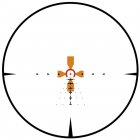I have had my first serious range session with the AR in 6ARC with the Sig Sauer mounted and it's an interesting learning experience. The scope is a low/mid cost optic, I paid well under $500, and I feel I got more than what I paid for, (it is not a precision scope and was bought for CQB games and medium game at cartridge capable ranges.
It's well made and has the standard issues of an LPVO. No parallax adjustment, at the higher power ranges the eye relief is only 3.2" I believe so I set the rifle and sling up to come to bear at that power as the 1 power setting has 9" of relief. I can carry at 1 power or 10 power and bring the rifle to bear quickly. The adjustment clicks as not as audible as I'd like.
At lower powers the glass is clear and bright, the scope is second focal plane and the bullet drop compensation reticle stays the same size at all power settings. At 10 power the scope is less light efficient but not so much as to make it ineffective. I was able to identify targets the size of ground hogs at 600 yards with it. At 1 power the rifle can be handled with both eyes open as the scopes field of view is no hinderance to operation.
The illuminated reticle is reasonably bright even on light surfaces in the sun but in my opinion better suited at lower power settings. Adjustments were true and repeatable, but you have to pay attention to hear or feel the clicks.
I have shot thousands of rounds with first focal plane varmint, law enforcement glass but not many rounds with a LPVO. It has been a learning experience, I managed to get elevations mapped out to 600 yards, but I was unhappy with my grouping. Being unaccustomed to the reticle I was unprepared with a fully functional target especially at ranges 300 and more, the rifle had been mounted with a varmint rig months ago and I knew it wasn't the rifle, so it had to be me and the scope combination. I did enough work to get a 300 yard zero, map back to 25 yards for holding positions and map hold over points on the BDC from 410 yards to 630 yards, in which I am confident that the rifle scope combination will be field worth of. However, my poor choice of target did not allow me to map lead/windage points on the reticle.
I'll upload the first target type used with the reticle superimposed upon it, all targets has the reticle superimposed upon them, my second image uploaded will be the one used to map the lead/windage points and the third will be a CQB 300-yard training target. It has a 9" white circle with a 3" black circle in the center, the 200 yard and the 100-yard version have corresponding 2" and 1" center black circles, to utilize the geometrics of the reticle type.


It's well made and has the standard issues of an LPVO. No parallax adjustment, at the higher power ranges the eye relief is only 3.2" I believe so I set the rifle and sling up to come to bear at that power as the 1 power setting has 9" of relief. I can carry at 1 power or 10 power and bring the rifle to bear quickly. The adjustment clicks as not as audible as I'd like.
At lower powers the glass is clear and bright, the scope is second focal plane and the bullet drop compensation reticle stays the same size at all power settings. At 10 power the scope is less light efficient but not so much as to make it ineffective. I was able to identify targets the size of ground hogs at 600 yards with it. At 1 power the rifle can be handled with both eyes open as the scopes field of view is no hinderance to operation.
The illuminated reticle is reasonably bright even on light surfaces in the sun but in my opinion better suited at lower power settings. Adjustments were true and repeatable, but you have to pay attention to hear or feel the clicks.
I have shot thousands of rounds with first focal plane varmint, law enforcement glass but not many rounds with a LPVO. It has been a learning experience, I managed to get elevations mapped out to 600 yards, but I was unhappy with my grouping. Being unaccustomed to the reticle I was unprepared with a fully functional target especially at ranges 300 and more, the rifle had been mounted with a varmint rig months ago and I knew it wasn't the rifle, so it had to be me and the scope combination. I did enough work to get a 300 yard zero, map back to 25 yards for holding positions and map hold over points on the BDC from 410 yards to 630 yards, in which I am confident that the rifle scope combination will be field worth of. However, my poor choice of target did not allow me to map lead/windage points on the reticle.
I'll upload the first target type used with the reticle superimposed upon it, all targets has the reticle superimposed upon them, my second image uploaded will be the one used to map the lead/windage points and the third will be a CQB 300-yard training target. It has a 9" white circle with a 3" black circle in the center, the 200 yard and the 100-yard version have corresponding 2" and 1" center black circles, to utilize the geometrics of the reticle type.













